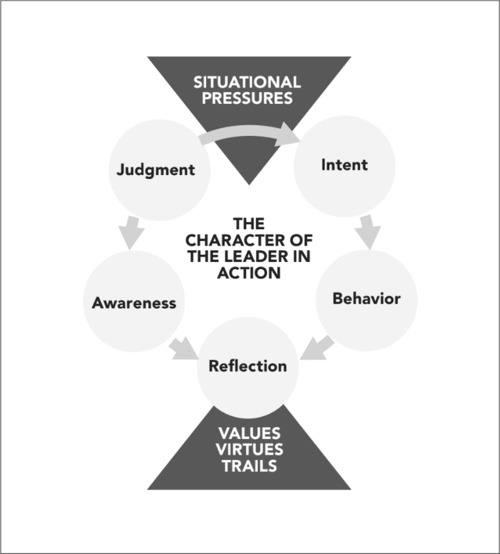The Way | Lead | Leading for and with Character
Character Leadership In Theory
Character leadership in practice can be improved by linking it to a theory that explains the decisions that drive this practice. We believe that character leadership is currently envisaged more in the daily doing, perhaps itself a by- product of the busy-ness to which most leaders would point, if they had the time to comment! If character leaders do find the time to reflect and develop a model of practice, any model that they construct for themselves about their leadership, therefore, might benefit from a clear alignment to the strategic educational intent of being a fit for purpose 21C school of character, and operational soundness in implementation of a plan to attain this intent.

It must include the development and promulgation of a compelling narrative that helps school members to understand where the journey is taking them and why it is necessary for them to join in to the collective enterprise. Part of this narrative needs to model change in perspective and growth in capability for all. This needs to encourage the contribution of all to the evidence-based community of inquiry and practice that will act as the knowledge engine for the school moving forwards. Finally, it requires leadership by example that is connected to the core of the school’s ethos and a willingness to undergo scrutiny of the effectiveness of this example.
If we assemble the components of the significant activity of school leaders in their character labor, we can align them to our six corridors of a 21C framework in the following fashion:
Strengthening
Leading through character adds to the value of a school. This is characterised by embedding shared values in a culture with a clear and meaningful core of civic character, performance character, and moral character. This draws on the leadership capability of disciplined and purpose-driven practice.
Informing
Leading through narrative creates shared purpose in a school. This is characterised by leading it towards a shared understanding of its context, trajectory, and sense of community. This draws on the leadership capability of creating and communicating vision.
Orientating
Leading through transformation commits the school to growth. This is characterised by adopting behaviours of self-efficacy and adaptive expertise in pursuit of the progressive attainment of iterative standards. This draws on the leadership capability of understanding and managing change.
Focusing
Leading through expectation concentrates the school on the solutions for the future derived from the best possible thinking. This is characterised by enacting strategic intent, paying attention to detail in implementation, and emphasising achievement of desired outcomes. This draws on the leadership capability of problem-solving and decision-making.
Aligning
Leading through intent draws the school together by building trust. This is characterised by promoting openness and responsibility, establishing commitment to a common aspiration, and resourcing for long-term success. This draws on the leadership capability of values-based leadership style.
Enriching
Leading through teams enhances the school by empowering people. This is characterised by conscious acknowledgement of the dignity, worth, and agency of individuals and groups within the community of inquiry and practice. This draws on the leadership capability of team cultivation.
This proposed rubric might, therefore, allow leaders to reflect on their practice in relation to a conceptual model for what leadership might become in a school of character. It might also allow for the development of a community of inquiry and practice in which leaders within and across schools might collaborate to test their practice against external and internal evidence of their process and impact. In other words, it might provide leaders in schools with the capacity to align what they do with the expectations that are being established for exemplary character education practice in schools. It might also help them to hold on when times are tough. As one leader told us, “The most important character work is to remain committed to the cause despite all of the problems ... and to ensure, through constant reiteration and good recruitment of the right people that the right values continue to be pushed to the fore.”
“My purpose as a leader for character is to act in a way that is aligned with core values and attitudes. As such, I believe in values- based leadership approaches. I always strive to ensure that my actions are aligned with my personal values and those of the College. I believe in honesty, integrity and acting in a way that serves others. It is my ambition to act in a way that inspires others to serve others.”
In our research, we considered the nature of character labor and proposed a process by which leaders can reflect on what and why they do what they do on an ongoing basis:
- How well does my character labor align with and strengthen the character education objectives in my school?
- How well does my character labor build my school’s character capital?
- Do I know the impact of my character labor on others? Am I to others what I believe I am to myself?
- Do I ‘project’ my character labor in ways that are ‘received’ and that register?
- Think of a time when you think you showed great character labor to develop character capital in your school. What made it successful? What did you take away and learn from it? Can you replicate it?
- Think of a time when your character labor didn’t feel so successful. What did it feel like? Why didn’t it seem to bear the result you wanted? What did you learn from it?
It is in the development of a reflective culture for character leadership that we see a way forward for sustainable practice in this area. It will also enable leaders to demonstrate that their work is purposeful, aligned, deliberate and focused in the same way as they would want the work of their staff and the work of the students to be. This leads us to propose a model for decision-making by leaders in schools (seen in the following figure) that helps them to draw on their own character and the strong practice of their colleagues in demonstration to ensure that the process and product of their decision-making sets the example that they want in building a school of character:

Effective character leaders, therefore, should draw on a process whereby they access both the situational pressures that confront them and also values virtues and traits that make up the core of their being. As one leader explains, “A leader for character is someone who leads by example. To add, this is someone who exemplifies character traits that include, dignity, integrity, perseverance, and courage. My vision as a leader is to inspire everyone around me to be great and make purposeful and ethically sound decisions. In addition to academics, being able to navigate through life’s adversities in a dignified way demonstrates one’s ability to control his or her destiny.” It is an internal process of the wrestling between realisation and replication which mirrors that which the students themselves undergo, enables them to develop solutions in times of crisis by navigating from the high moral ground, as well as ensuring that on a daily basis, what they do is based on a growth cycle of reflection on judgment, intent, behaviour, and awareness in a transparent fashion.
In this, as in every other way, leaders might be empowered to lead by demonstrating the same qualities, competencies and character that they wish to inspire in others. They become a physical representation of the alignment of vision, means and implementation that they seek in others. Their own personal character capital is invested into the school community and repaid in kind. As one leader explains, “I believe that we are first and foremost examples to others. I strive to live with the integrity that I expect from the learners in my classroom and in all other spheres of influence. I also believe that every child has the right and need to be themselves, and be true to themselves, but that they also have a responsibility to others and their rights to be themselves ... affirming the existing character of boys is important, but that we are duty bound to also affirm this in all other people. My vision is, therefore, that only through building relationships – creating a deep understanding of self and those who are not like you – can we truly be citizens of our school, our country and the world. The South African concept found in the Zulu word, ‘Ubuntu’, (loosely translated as “I am because we are”) underpins this.”
A great 21C school, a school of character, empowers its leaders to explain and convince the community of the vision, vocabulary, value proposition and velocity of necessary change. It equips itself with strong strategic foundations and a narrative for authentic educational innovation that walks the community through the adventure and the journey ahead. It provides its community members with systems and processes that bring them together to build professional self-efficacy and adaptive expertise, and then enables its learning community to build an evidence-based community of practice that both evolves routinely, and successfully meets the community’s expectations for performance, particularly with student outcomes. The courage and conviction required to construct this message and convince a school community of its validity and value is an ongoing act of persuasive leadership that becomes in many ways the defining character of a school leader.
We know, therefore, that school leaders build character capital in a school community through character labor, especially through role modelling and the development of character competency. Character education efficacy results from their will and their capacity to embed a shared commitment to ‘what we want, why we want it and how we do it’ in character education. As one leader puts it, “My purpose as a leader for character is to act in a way that is aligned with core values and attitudes. As such, I believe in values- based leadership approaches. I always strive to ensure that my actions are aligned with my personal values and those of the College. I believe in honesty, integrity and acting in a way that serves others. It is my ambition to act in a way that inspires others to serve others.”
The reflections of character leaders in schools for boys reveals a clear repertoire of actions, interactions, behaviours, skills identified by leaders that they regularly deploy in their day-to-day work to support the character focus of their schools and to support boys in their character development. This is of great interest and provides an opportunity for further investigation and discussion. These tactical approaches provide guidance at least to the daily, embedded, transactional work of character leadership, grounded in a deliberately crafted visibility and presence. We have the impression that most of these leaders ‘do’ leadership for character in relative isolation or at least without much detailed or formal feedback on their effectiveness in this work. The lack of reference to a prevailing model of decision- making in character leadership nor of notions of the type of character labor performed and character capital that is built within a community suggest the need for a practice- based theoretical understanding that could be shared more widely. Even the level of observational feedback by peers suggested by the focus of this question would introduce the possibility of a community of leadership practice for leadership teams.
It is the quality and consistency of the character labor of school leaders that determines the quantum of character capital in a school; they show the way and multiply their personal investment of commitment and effort with the collective investment and support of the community. We need our school leaders to think more about their own models for the practice of character leadership in this respect.






